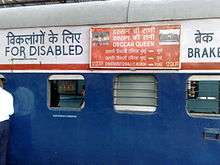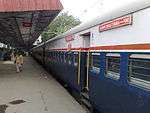Deccan Queen
The Deccan Queen or Deccan Queen Express, is an Indian passenger train that connects the two largest cities of the Indian state of Maharashtra, i.e. Mumbai and Pune. The service was named as Deccan Queen after the nickname for Pune: Queen of the Deccan.
 | ||||||||||||||||||||||||||||||||||||||||||||||||||||||||||||||||||||||||
| Overview | ||||||||||||||||||||||||||||||||||||||||||||||||||||||||||||||||||||||||
|---|---|---|---|---|---|---|---|---|---|---|---|---|---|---|---|---|---|---|---|---|---|---|---|---|---|---|---|---|---|---|---|---|---|---|---|---|---|---|---|---|---|---|---|---|---|---|---|---|---|---|---|---|---|---|---|---|---|---|---|---|---|---|---|---|---|---|---|---|---|---|---|---|
| Service type | Superfast | |||||||||||||||||||||||||||||||||||||||||||||||||||||||||||||||||||||||
| Locale | Maharashtra | |||||||||||||||||||||||||||||||||||||||||||||||||||||||||||||||||||||||
| First service | 1 June 1930 | |||||||||||||||||||||||||||||||||||||||||||||||||||||||||||||||||||||||
| Current operator(s) | Central Railway | |||||||||||||||||||||||||||||||||||||||||||||||||||||||||||||||||||||||
| Route | ||||||||||||||||||||||||||||||||||||||||||||||||||||||||||||||||||||||||
| Start | Chhatrapati Shivaji Maharaj Terminus | |||||||||||||||||||||||||||||||||||||||||||||||||||||||||||||||||||||||
| Stops | 3 as 12123 Deccan Queen express 2 as 12124 Deccan Queen express (+2 technical) | |||||||||||||||||||||||||||||||||||||||||||||||||||||||||||||||||||||||
| End | Pune Junction | |||||||||||||||||||||||||||||||||||||||||||||||||||||||||||||||||||||||
| Distance travelled | 192 km (119 mi) | |||||||||||||||||||||||||||||||||||||||||||||||||||||||||||||||||||||||
| Average journey time | 3 hours 10 minutes as 12124 Deccan Queen express 3 hours 15 minutes as 12123 Deccan Queen express | |||||||||||||||||||||||||||||||||||||||||||||||||||||||||||||||||||||||
| Service frequency | Daily | |||||||||||||||||||||||||||||||||||||||||||||||||||||||||||||||||||||||
| Train number(s) | 12123 / 12124 | |||||||||||||||||||||||||||||||||||||||||||||||||||||||||||||||||||||||
| On-board services | ||||||||||||||||||||||||||||||||||||||||||||||||||||||||||||||||||||||||
| Class(es) | AC Chair Car, Chair Car, General | |||||||||||||||||||||||||||||||||||||||||||||||||||||||||||||||||||||||
| Seating arrangements | Yes | |||||||||||||||||||||||||||||||||||||||||||||||||||||||||||||||||||||||
| Sleeping arrangements | No | |||||||||||||||||||||||||||||||||||||||||||||||||||||||||||||||||||||||
| Auto-rack arrangements | No | |||||||||||||||||||||||||||||||||||||||||||||||||||||||||||||||||||||||
| Catering facilities | Yes, paid service | |||||||||||||||||||||||||||||||||||||||||||||||||||||||||||||||||||||||
| Observation facilities | Very few stops, No Rake Shareing | |||||||||||||||||||||||||||||||||||||||||||||||||||||||||||||||||||||||
| Entertainment facilities | None | |||||||||||||||||||||||||||||||||||||||||||||||||||||||||||||||||||||||
| Other facilities | Dining Car (Restaurant On Wheels) | |||||||||||||||||||||||||||||||||||||||||||||||||||||||||||||||||||||||
| Technical | ||||||||||||||||||||||||||||||||||||||||||||||||||||||||||||||||||||||||
| Rolling stock | Ajni WAP 7 locomotive, ICF Blue White Rake | |||||||||||||||||||||||||||||||||||||||||||||||||||||||||||||||||||||||
| Track gauge | 1,676 mm (5 ft 6 in) | |||||||||||||||||||||||||||||||||||||||||||||||||||||||||||||||||||||||
| Operating speed | 105 km/h (65 mph) top speed 58 km/h (36 mph) average with halts | |||||||||||||||||||||||||||||||||||||||||||||||||||||||||||||||||||||||
| ||||||||||||||||||||||||||||||||||||||||||||||||||||||||||||||||||||||||
Deccan Queen is currently the fastest train service linking Chhatrapati Shivaji Maharaj Terminus and Pune Junction. It has an average operating speed of 58 km/h (36 mph) including stops, and a top speed of 105 km/h (65 mph), making it among the fastest trains in India.
History
Deccan Queen service was introduced on 1 June 1930[1] as a weekend train during the days of the British raj to ferry rich patrons -fans from Bombay (now Mumbai) to Poona (now Pune) to attend horse racing at Pune Race Course.The first service of the train was conducted from Calyan (now Kalyan) and Pune. It was converted to a daily service soon after, starting from Bombay Victoria Terminus (renamed Mumbai Chhatrapati Shivaji Maharaj Terminus CSMT). It is one of the longest running train service on the Indian Railways to have never run on steam power. From the beginning, the Deccan Queen has been run using electric locomotives. Occasionally, it was given diesel locomotives in case of original locomotive failure.
The color of its rake has seen a lot of changes, from red colour to yellow to white and then to blue.[1]
The Deccan Queen has several firsts or 'among the firsts' to her credit: she was India's first superfast train, she was the first long distance electric hauled passenger train, she was one of India's first vestibuled trains. The Deccan Queen was the first to have a Ladies Only car, and amongst the first to feature a diner. The train has an exciting and chequered history. The Deccan Queen got a brand new rake in 1966, consisting of Indian Railways standard integral anti telescopic cars. For the first time since the history of the train, third class (now second class) passengers were allowed to travel by this train. It had only reserved first class since inception until 1966.
Deccan Queen is the second train in India having ISO 9000 certification and a dining car after the India's first ISO Certified train Shaan - E - Bhopal Express running between Bhopal Habibganj (Bhopal) - Hazrat Nizamuddin (Delhi).[1] It has sixteen coaches including the engine.
The Deccan Queen is also one of the most favourite trains among railfans. Every year on 1 June, its regular pass-holders, railfans and railway authorities celebrate the train's birthday. Deccan Queen entered its 90th year of service on 1 June 2019.
Accident
On the 29th December, 1953, Bombay- bound Deccan Queen collided at Masjid Bunder station with another local train at 10–25 hours on 29 December 1953. Five persons received grievous and 42 others minor injuries. The approximate cost of damage to railway property was Rs. 12.600. The Government Inspector of Railways, Bombay, held his statutory enquiry into this accident. His Provisional Finding is that the accident was caused by the failure on the part of the Driver of the Deccan Queen.[2]
Schedule
The Pune Mumbai Deccan Queen Express Express is the 2nd of 6 dedicated trains to leave Pune Junction for Mumbai CSMT & is the last train to return.
12124 Pune Mumbai Deccan Queen Express leaves Pune Junction every day at 07:15 hrs IST and reaches Mumbai CSMT at 10:25 hrs IST. The train travels non stop till Lonavala after leaving Pune junction. On its way the train overtakes Sahyadri Express at Shivajinagar / Khadki. Then it crosses the Bhor ghat and skips Karjat. The train then stop at Dadar (Central) station after traveling 120 km (75 mi) from Lonavala and finally terminates at Mumbai CSMT.
On return, the 12123 Mumbai Pune Deccan Queen Express leaves Mumbai CSMT every day at 17:10 hrs IST and reaches Pune Junction at 20:25 hrs IST. On its way the train halt at Karjat after covering 100 km (62 mi) from Mumbai CSMT for bank locomotive attachment. Then it halts at Lonavala after crossing Bhor Ghat where bank locomotives are detached. Then the train halts at Shivajinagar a major suburb of Pune before terminating at Pune junction.
Deccan Queen is Central Railway's flagship train but is often late by 30 minutes when arriving in Mumbai due to suburban network local trains.[3] Deccan Queen, when it started in 1930 was one of the fastest trains in Asia. It used to cover the 192 km Mumbai-Pune distance in 3 hours 45 minutes and now takes 3 hours 15 minutes.[4]
Coaches
This train uses ICF coaches. This train has a dining car and is ISO certified train. This train has 17 coaches which include different classes like AC chair car, MST coaches (Monthly Season Ticket), Ladies special, Second class sitter, Reserved coaches and General Coaches. This train will be upgraded under project utkrisht and will have LED lights, Bio toilets and Braille Signage. GPS-tagged biometric attendance system will be also installed in this train.[5]
Rake
Initially this train use to run with two different rakes one colored silver with scarlet moldings and other royal blue, both built in England. Only First Class and Second Class were used in seven coach rake till June 1955 after which Third Class was also introduced. Initially there were seven coaches which were increased to 12 and then to 17 as of today.[6] Now it has one dedicated rake colored white and blue with red strip on white color. The rake is ICF rake and was hauled by WCAM 3 or WCAM 2/2P until it was changed to WAP 7 (P7) which hauls the train today. The rake is attached with bankers from Karjat to Lonavala while traveling from Mumbai CSMT to Pune Junction. to cross steep climbs of the Bhor Ghat.
- Mumbai CSMT - Pune Junction
| Loco | 1 | 2 | 3 | 4 | 5 | 6 | 7 | 8 | 9 | 10 | 11 | 12 | 13 | 14 | 15 | 16 | 17 |
|---|---|---|---|---|---|---|---|---|---|---|---|---|---|---|---|---|---|
| HP/SLR | (Second MST) |
(Second MST) |
GEN | GEN | D5 | D4 | D3 | Dining cum Pantry Car | C4 | C3 | (AC MST) |
(AC MST) |
D2 | D1 (LADIES) |
GEN | SLR/HP |
- Pune Junction - Mumbai CSMT
| 17 | 16 | 15 | 14 | 13 | 12 | 11 | 10 | 9 | 8 | 7 | 6 | 5 | 4 | 3 | 2 | 1 | Loco |
|---|---|---|---|---|---|---|---|---|---|---|---|---|---|---|---|---|---|
| HP/SLR | (Second MST) |
(Second MST) |
GEN | GEN | D5 | D4 | D3 | Dining cum Pantry Car | C4 | C3 | (AC MST) |
(AC MST) |
D2 | D1 (LADIES) |
GEN | SLR/HP |
Traction
When it was introduced in 1930, the Deccan Queen was hauled by WCP 1/2 DC passenger locomotives. From 1954 till the 1990s, it was hauled by a WCM-1/2/4/5 DC mixed locomotive. From the 1990s till present, it has been hauled end to end by a WCAM 3 or WCAM 2/2P DC/AC locomotive of the Kalyan (KYN) shed. Starting 1 June 2018, on its 88th anniversary, it will be occasionally hauled by the WAP-7 of the Ajni shed.[7]
At Karjat, it gets two or three WAG-5, WAG-7, WCAM-2 or WCAM 3 bankers of Kalyan shed to push the train on the ghat section between Karjat railway station and Lonavala railway station, where the gradient is of 1 in 40.
Incidents
The train derailed in 1990 at Khandala Ghat, casualties were not reported.
The train service was disturbed between late July to early August 2005 due to heavy rainfall in Mumbai (26 July 2005).
On 30 November 2006, a mob of around 6000 protestors set fire to some coaches of the train near Ulhasnagar after forcing the passengers to get down.[8] The arsonists were protesting against the vandalism of a statue of B. R. Ambedkar in far away Kanpur though the incident had nothing to do with the Deccan Queen.
Gallery
 Deccan Queen at Mumbai CSMT
Deccan Queen at Mumbai CSMT The Deccan Queen during its 80th anniversary celebrations on 1 June 2009
The Deccan Queen during its 80th anniversary celebrations on 1 June 2009- WCM 1 type engine initially was used to pull Deccan Queen
Sister trains
| Via Kalyan | Via Panvel | Defunct |
|---|---|---|
| Deccan Express | Pragati Express | Poona Mail |
| Indrayani Express | ||
| Mumbai Pune Intercity Express | Mumbai-Pune Shatabdi Express | |
| Sinhagad Express |
See also
References
- "Deccan Queen turns 75". 1 June 2004. Retrieved 30 November 2006.
- https://eparlib.nic.in/bitstream/123456789/55680/1/lsd_01_06_05-03-1954.pdf page 4
- Commuters claim Deccan Queen reaches Mumbai late
- Wish List for Pune – Mumbai Railway Corridor
- Reporter, Staff (25 May 2018). "Deccan Queen to get upgraded coaches". The Hindu.
- "Iconic Mumbai-Pune Deluxe train Deccan Queen celebrates 88th anniversary". June 2018.
- 12123/Deccan Queen, indiarailinfo.com
- "Dalits go on a rampage". 30 November 2006. Archived from the original on 22 June 2017. Retrieved 30 November 2006.